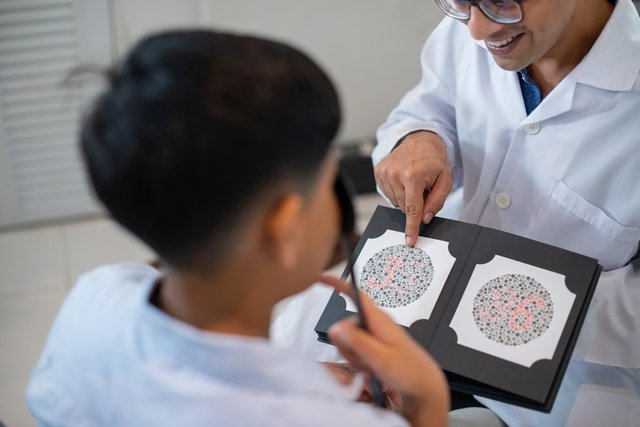Child color blindness tests aim to assess the child’s ability to distinguish different shades of colors, which can be done using cards, colored discs and woolen threads, for example. Some tests can be taken by children aged 4 and over.
Color blindness is a visual disorder in which a person cannot distinguish colors very well, especially red and green, which may be due to genetic changes or as a result of injuries to the ocular structures. Learn more about color blindness.
Although some tests for childhood color blindness can be done online, it is recommended to consult an ophthalmologist for a more detailed evaluation if suspected. Identifying children’s color blindness is important to enable greater child participation in the classroom and encourage their learning.

Main tests
The main tests used to identify childhood color blindness are:
1. Ishiara tests
The Ishiara test is one of the most used color blindness tests, and is normally recommended for children aged 7 and over. It is done with the guidance of an ophthalmologist and its most common version involves identifying numbers within colored images on cards.
If you want to make an appointment, you can find the ophthalmologist closest to you using the tool below:
Taking care of your health has never been easier!
There are other versions of this test that are carried out by identifying the shape of specific objects or animals instead of numbers, for example, which can identify childhood color blindness in children aged 4 and over.
2. Farnsworth-Munsell 100 Shade Test
The Farnsworth-Munsell 100 shade test is a test that involves organizing colored discs into 4 groups, following an order based on their color. It can be done by children from 5 years of age.
Children with color blindness tend to have greater difficulty performing this activity, and in some cases they may have errors in the entire test or just in a specific color, depending on the severity of the color blindness.
3. Holmgren wool test
The Holmgren wool test consists of combining strands of colored wool yarns with different shades according to their color, in an order indicated by the doctor who is performing the test.
4. Electroretinography
Although less used, electroretinography is a more invasive exam that aims to check the eye’s electrical response to light stimuli. It may be indicated in some cases where color blindness is suspected and can also identify other eye changes.
Online test for color blindness
Online tests for color blindness are typically based on the Ishihara test and can be taken by adults and children. However, the most common tests involve identifying numbers and therefore may not be suitable for identifying childhood color blindness in young children, especially before the age of 7. See what the online test for color blindness looks like.
Although online tests can be carried out at home to initially check the ability to distinguish colors, it is important that the diagnosis is confirmed by an ophthalmologist, who can carry out a more detailed vision assessment.
When to suspect childhood color blindness
It is usually possible to suspect childhood color blindness from the age of 3, which is more or less the age at which children begin to learn colors. Thus, in case of color blindness, the child is unable or has difficulty making the distinction.
However, the diagnosis is only confirmed in older children, when they are able to collaborate more with the tests, better identifying figures and numbers during the assessment.
In case of suspected child color blindness, it is important that the ophthalmologist is consulted, as tests are carried out to help confirm the diagnosis and strategies can be indicated that can help the child with their difficulties.
We regularly update our content with the latest scientific information, so that it maintains an exceptional level of quality.
Bibliography
- CRANWELL, Matthew B. et al. Performance on the Farnsworth-Munsell 100-Hue Test Is Significantly Related to Nonverbal IQ. IOVS. Vol.56. 3171-3178, 2015
- SCIENCE MUSEUM GROUP. Holmgren’s coloured wool test for colour blindness, Europe, 1871-1900. Disponível em: <https://collection.sciencemuseumgroup.org.uk/objects/co153184/holmgrens-coloured-wool-test-for-colour-blindness-europe-1871-1900-colour-blindness-test>. Acesso em 26 out 2023
- DEEB, Somir S; MOTULSKY, Arno G. Chapter 133 – Color Vision Defects. In: Emery and Rimoin’s Principles and Practice of Medical Genetics. 6.ed. Academic Press, 2013. 1-17.
- NIH. Testing for Color Vision Deficiency. Disponível em: <https://www.nei.nih.gov/learn-about-eye-health/eye-conditions-and-diseases/color-blindness/testing-color-vision-deficiency>. Acesso em 26 out 2023
- AAO. Testing Children for Color Blindness. Available at: <https://www.aao.org/eye-health/news/testing-children-color-blindness>. Accessed on October 26, 2023
- AAO. What Is Color Blindness?. Disponível em: <https://www.aao.org/eye-health/diseases/what-is-color-blindness>. Acesso em 25 out 2023

Sign up for our newsletter and stay up to date with exclusive news
that can transform your routine!
Warning: Undefined array key "title" in /home/storelat/public_html/wp-content/plugins/link-whisper-premium/templates/frontend/related-posts.php on line 12
Warning: Undefined array key "title_tag" in /home/storelat/public_html/wp-content/plugins/link-whisper-premium/templates/frontend/related-posts.php on line 13



